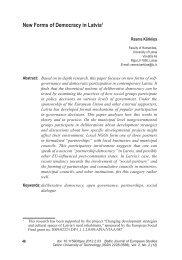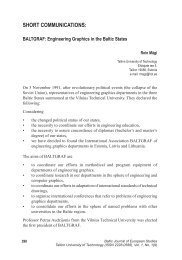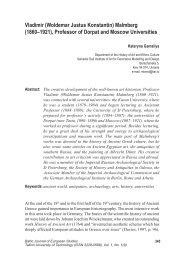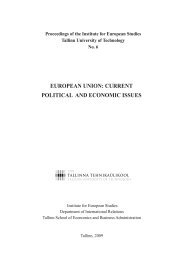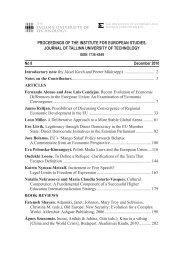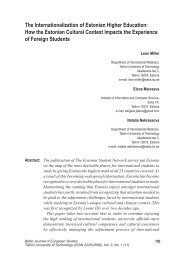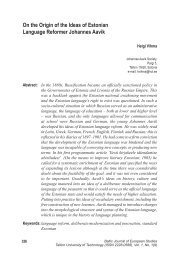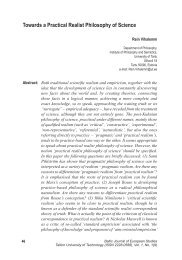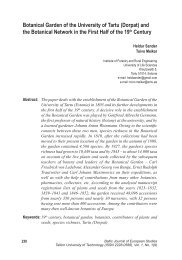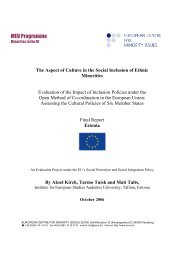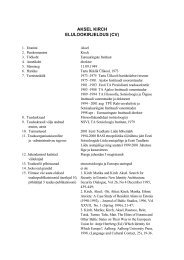Arutyun Arutyunyan. Intellectual Property Law vs. Essential Facility ...
Arutyun Arutyunyan. Intellectual Property Law vs. Essential Facility ...
Arutyun Arutyunyan. Intellectual Property Law vs. Essential Facility ...
Create successful ePaper yourself
Turn your PDF publications into a flip-book with our unique Google optimized e-Paper software.
intellectual property and competition law are both equally aimed at<br />
maximizing social welfare. While competition law seeks to achieve this by<br />
eliminating behavior and practices that restrict competition, intellectual<br />
property law pursues this aim by creating legal monopolies. It is from the<br />
friction of these two opposing and different policies that the conflict arises.<br />
In recent years, the question of how to fashion a remedy that would properly<br />
balance these competing interests in those rare cases where refusal to license<br />
constitutes a violation of competition law is debated widely. 1<br />
This paper will analyse the current state of the law on compulsory licensing<br />
of intellectual property rights pursuant to Article 82 of the EC Treaty 2 , with<br />
particular reference to the Microsoft action, which is currently before EC<br />
courts. 3<br />
I A. Article 82<br />
Many of the most controversial decisions by the Commission have been<br />
taken under Article 82 4 . Its largest fine in a single decision- EUR 497<br />
million- was in an Article 82 case, where Microsoft was and still is<br />
1 See Giovanni Ramello, G.B., ‘Copyright and Antitrust Issues. The Economics of<br />
Copyright, Developments in Research and Analysis’ [2003] Wendy Gordon and Richard<br />
Watt, eds., Edward Elgar Publishers Ltd. available at SSRN:<br />
<br />
2 Consolidated Version of the Treaty Establishing the European Community (EC Treaty)<br />
3 When referring to the ‘Court’ the author refers to the European Court of Justice in general,<br />
not separating the ECJ and the CFI as such in order to avoid confusion. Council Decision<br />
93/350 (1993 OJ L144/21) transferring the private actions to the Court of First instance.<br />
Where necessary the distinction is brought out.<br />
4 Article 82 reads as follows: “Any abuse by one or more undertakings of a dominant<br />
position within the common market or in a substantial part of it shall be prohibited as<br />
incompatible with the common market in so far as it may affect trade between Member<br />
States. Such abuse may, in particular, consists in:<br />
a) Directly or indirectly imposing unfair purchase or selling prices or unfair trading<br />
conditions<br />
b) Limiting production, markets or technical development to the prejudice of<br />
consumers<br />
c) Applying dissimilar conditions to equivalent transactions with other trading<br />
parties, thereby placing them at a competitive disadvantage<br />
d) Making the conclusion of contracts subject to acceptance by the other parties of<br />
supplementary obligations which, by their nature or according to commercial<br />
usage, have no connection with the subject of such contracts.<br />
168
considered to have abused its dominant position in the market for operating<br />
systems for personal computers (PCs) between 1998 and 2004. For the<br />
purposes of this paper Article 82 plays a very important role, and thus one<br />
should understand what the Article is about.<br />
According to the above mentioned Article a dominant position in the<br />
relevant market is not itself illegal, nor is it prohibited and incompatible<br />
with the general purposes of the rules set out for the common market. “It is<br />
consumer welfare that is at the heart of the European Commission’s<br />
competition policy” 1 and therefore, as long as consumers’ choice and<br />
product quality are not affected by the presence of a single player or a<br />
company which has a dominant position in the market, this is not prohibited<br />
by the European competition policy. It is the abuse of such dominant<br />
position that is proscribed by Article 82. Firms are encouraged to compete<br />
and in the end the most efficient players should be successful. Thus, those<br />
who have been more efficient and attained market strength should not be<br />
penalized just for being dominant players, but a penalty may be imposed by<br />
the Commission for behavior of a firm with the power over the market that<br />
can affect the degree of competitiveness in the internal market. 2 This view<br />
has been stated by the previous European Competition Commissioner Mario<br />
Monti: “Dominant companies have a special responsibility to ensure that the<br />
way they do business doesn’t prevent competition on [the] merit[s] and does<br />
not harm consumers and innovation”. 5<br />
B. <strong>Essential</strong> <strong>Facility</strong> Doctrine<br />
There are circumstances in which a refusal to supply goods or services or to<br />
grant access to a so-called ‘essential facility’ by a dominant undertaking can<br />
1 Walker, M. and Bishop, S., The Economics of EC Competition <strong>Law</strong>, 2 nd ed. (London:<br />
Sweet and Maxwell Publishing, 2002) Section 2.22<br />
2 Craig, P. and De Burca, G., EU <strong>Law</strong> Text, Cases, and Materials, 3 rd ed. (Oxford: Oxford<br />
University Press, 2003) at p.p.992-993<br />
5 See Press Release IP/04/382, European Commission, Commission concludes on Microsoft<br />
investigation, imposes conduct remedies and a fine, March 24, 2004<br />
169
amount to an abuse of a dominant position. The Microsoft case has shown<br />
that refusal to supply is a controversial and difficult topic in competition<br />
law. There are several reasons why refusal to cooperate or grant access to<br />
facilities leads to difficulties. Firstly, the legal systems of most countries<br />
with a market economy support the view that firms have the freedom to<br />
conclude contracts with whomever they want and for this reason,<br />
compulsory licensing is not a generally accepted legal norm. Secondly, there<br />
are different views on the circumstances where undertakings should be<br />
required to supply. There is also no uniformity on what constitutes an<br />
objective justification for not supplying. Thirdly, compulsory licensing can<br />
have different impacts on an economy and it may not be conducive to<br />
economic welfare, e.g. if ‘free riders’ exploit the benefits of other firms’<br />
investments. 1<br />
The last point is particularly important for the issue of ‘essential facilities’<br />
and particularly for the case Microsoft <strong>vs</strong>. Commission. 2 The expression<br />
‘essential facility’ was introduced into EC competition law by Commission<br />
Decision in Sealink/B&I-Holyhead 3 in 1992. Mandatory access to a facility<br />
that is deemed to be essential for competitors to enter downstream markets<br />
is one of the main regulatory measures and antitrust remedies implemented<br />
worldwide and in Europe as well. This seems to have come about as a result<br />
of the liberalization of markets in network industries previously covered by<br />
publicly owned monopolists. 4<br />
The creation of a wholesale market for the facility in question is generally<br />
aimed in improving the extent of competition in downstream markets. A<br />
vertically integrated owner of essential facility is able to extend monopoly<br />
or dominant position to a downstream market, according to the degree to<br />
which the facility is somehow substitutable by other assets. 5 In the last<br />
1 Whish, R., Competition law, 5 th ed. ( UK: LexisNexis, 2003), p.663<br />
2 Case T-313/05, Microsoft v. Commission, [2005] OJ C257/16<br />
3 Commission Decision 92/34/174 Sealink/B&I-Holyhead, interim measures, not published.<br />
This case will be mentioned further in the paper.<br />
4 Armstrong, M., Cowan S., and Vickers J., Regulatory Reform: Economic Analysis and<br />
British Experience, (Cambridge: MIT Press, 1994)<br />
5 Castaldo A., Nicita A., ‘<strong>Essential</strong> <strong>Facility</strong> and Efficiency in European Antitrust. Some<br />
Lessons from GVG/FS in the Railway Sector’ [2005], May 31 2006, University of Siena,<br />
Faculty of Economics, available at <br />
170
fifteen years, the Commission has made extensive use of essential facility<br />
doctrine to introduce competition in markets where the existence of essential<br />
facility constitutes an insuperable barrier to entry. While this doctrine was<br />
initially applied to port infrastructures 1 , it has now been expanded to a large<br />
number of facilities such as telecommunications, electricity, gas, railways,<br />
the postal sector, oil and gas pipelines, airports, ground-handling services,<br />
set-top boxes, computer reservation systems, international networks for<br />
transferring payment messages, etc. 2 The circumstances in which a refusal<br />
to supply infringes Article 82 EC are controversial. This is even further<br />
complicated by different types of refusal to supply and because such refusals<br />
may take a number of different forms. In particular, a refusal to supply may<br />
be “unilateral” or “concerted” 3 ; the refusal may be to supply a competitor or<br />
a customer who is not an actual or potential competitor. A refusal to supply<br />
a competitor may be a “first-time” refusal to supply 4 or may consist in the<br />
termination of an existing business relationship. 5 In each of these different<br />
situations an undertaking in question may refuse to supply, or it may make a<br />
“constructive” refusal to supply by an offer on very disadvantageous terms. 6<br />
Moreover, a refusal may be a refusal to supply tangible products, to provide<br />
access to certain physical infrastructure, to provide services or to license<br />
1 See Commission Decision 94/119/EC, Port of Rodby, (1994 O.J. L 55/52); Commission<br />
Decision 94/19/EC, Sea Containers/Stena Sealink, (1994 O.J. L 15/8); Commission<br />
Decision 92/34/174 Sealink/B&I-Holyhead, interim measures, not published.<br />
2 See Whish, R., supra 11.<br />
3 See US v. Terminal Railroad 224 U.S. 383 (1912); Associated Press v. United States, 326<br />
U.S. 1 (1945), or collective boycott cases.<br />
4 See particularly Joined cases C-241/91P and C-242/91P, Radio Telefis Eireann and others<br />
v. Commission (Magill), [1995] ECR I-743; Case C-7/97, Oscar Bronner v. Mediaprint,<br />
[1998] ECR I-7791; Case T-504/93, Tierce Ladbroke SA v. Commission, [1997] ECR II-<br />
923; Case C-418/01, IMS Health v. NDC Health, not yet reported; Otter Tail Power Co. v.<br />
United States, 410 U.S. 366 (1973); Verizon Communications Inc. v. <strong>Law</strong> Offices of Curtis<br />
V. Trinko, 540 U.S. 682, (2004)<br />
5 See Joined cases 6/73 and 7/73, Commercial Solvents v. Commission, [1974] ECR 223;<br />
Case 311/84, Centre Belge d’Etudes de Marche-Telemarketing (CBEM) v. SA Compagne<br />
Luxembourgeoise de Telediffusion (CLT) and Information Publiciti Benelux (IPB)<br />
(Telemarketing), [1985] ECR 3261; Aspen Skiing Co. v. Aspen Highlands Skiing Corp., 472<br />
U.S. 585(1985).<br />
6 See Commission Decision 2001/892/EC, Deutsche Post- Interception of cross-border<br />
mail, (2001 OJ L 331/40), para.141; and Commission Decision 1999/243/EC, Trans-<br />
Atlantic Conference Agreement (TACA), (1999 OJ L 95/1), para.553<br />
171
intellectual property rights (IPRs) 1 . Many commentators criticize the law in<br />
this area as being uncertain, specifically lacking a proper conceptual<br />
framework and economic rigour. 2 There is a necessity for clarity and legal<br />
certainty - rules must be predictable. This is a firmly established principle of<br />
the EC law. 4<br />
One of the questions relating to the extent to which dominant firms in<br />
possession of essential facilities (products or services) should be mandated<br />
to give access to these inputs to their competitors is of particular interest for<br />
the present paper. The problem is that there should be an economic response<br />
in deciding essential facility issues and, particularly, compulsory licensing.<br />
While granting access to “essential facilities” will stimulate competition in a<br />
secondary market 5 , it has the risk of reducing incentives for holders of<br />
essential facility. It also raises questions about the role of the competition<br />
authorities and the courts. Compulsory licensing involves complex pricerelated<br />
questions for which both the European Commission and the ECJ/CFI<br />
are poorly equipped.<br />
C. <strong>Intellectual</strong> <strong>Property</strong> Rights and Competition <strong>Law</strong><br />
The standard theory of interface between intellectual property rights and<br />
competition law is that:<br />
“Both bodies of law share the same basic objective of promoting consumer<br />
welfare and an efficient allocation of resources. IPR promotes dynamic<br />
competition by encouraging undertakings to invest in developing new or<br />
improved products and processes. So does competition by putting pressure<br />
on undertakings to innovate. Therefore, both IPR and competition are<br />
1 Humpe, C. and Ritter, C., ‘Refusal to Deal’ (Global Competition <strong>Law</strong> Centre Research<br />
Papers on Article 82 EC, July 2005).<br />
2 Ibid.<br />
4 “[I]t is necessary to emphasize, as the Court has already done on several occasions, that<br />
Community legislation must be unequivocal and its application must be predictable for<br />
those who are subject to it.” Case 70/83, Gerda Kloppenburg v. Finanzamt Leer<br />
(Kloppenburg), [1984] ECR 1075, para.11<br />
5 By contributing to allocative efficiency<br />
172
necessary to promote innovation and ensure competitive exploitation<br />
thereof.” 1<br />
However, the common goal of economic efficiency does not preclude a<br />
certain tension between these two bodies of law. The grant of an intellectual<br />
property right may shackle competitive market processes. There are two<br />
forms of competition to be considered: product competition and research<br />
competition. The first one provides allocative efficiency and gives<br />
consumers the opportunity to buy products at their market price. Research<br />
competition produces new products and technologies. This type of<br />
competition allows undertakings to escape from the constraints of product<br />
competition. 2<br />
A market economy does not necessarily provide an optimal amount of<br />
innovation. Granting the original inventor an exclusive right is viewed as an<br />
ex ante incentive to innovate by prohibiting free-riding. Thus, a grant of<br />
intellectual property right in the product market is part of a trade-off:<br />
“[a]like ordinary property rights that promote competition in production by<br />
preventing competition in consumption, intellectual property rights are a<br />
way (but not the only one) to promote innovation, by restricting some kinds<br />
of competition in production”. 3<br />
II. European Case <strong>Law</strong> on <strong>Essential</strong> Facilities and Compulsory<br />
Licensing<br />
Some of the most significant decisions of the European Commission and the<br />
Court of Justice should be mentioned in order to better understand the<br />
Commission Decision in Microsoft. Under the EC law the Court of Justice<br />
first dealt with refusals to deal in the case of Commercial Solvents. 4 In this<br />
1 Commission Notice - Guidelines on the application of Article 81 EC to technology<br />
transfer agreements, (2004/C 101/02)<br />
2 Aghion, P., Harris, C. and VICKERS J., ‘Competition and Growth with step by step<br />
Innovation: An Example’ [1997] European Economic Review, Papers and Proceedings, pp.<br />
771-782. See also Encaoua, D. and Ulph, D., ‘Catching-up or leapfrogging? The effects of<br />
Competition on Innovation and Growth’ [2000] Cahier de la MSE, EUREQua,<br />
W.P.2000.97<br />
3 Vickers, J., ‘Competition policy and innovation’, [2001] Office of Fair Trading, Speech to<br />
the International Competition Policy Conference, Oxford<br />
4 Joined cases 6/73 and 7/73, Commercial Solvents v. Commission, [1974] ECR 223<br />
173
leading case the Court found that under certain circumstances an<br />
undertaking in the dominant position had a duty to deal with another<br />
undertaking operating in a downstream market.<br />
In Magill 1 , the Court had the opportunity to define the notion of abusive<br />
conduct. The Community Courts upheld the Commission’s finding that<br />
three television companies broadcasting programmes in the UK and Ireland<br />
(BBC, ITP and RTE) had each abused an individual dominant position by<br />
refusing to make available details of their television schedules to a television<br />
listings magazine which would contain details of all three broadcasters’<br />
programmes. It should be noted that no such publication existed at the time. 2<br />
This case required the owners of intellectual property rights to grant licenses<br />
of those rights to third parties or, in other words, it was a compulsory<br />
licensing case. 3 The Court of Justice held that the exercise of an exclusive<br />
right by its owner may, in exceptional circumstances, involve abusive<br />
conduct. 4 In this particular case, the abusive conduct emerged from the fact<br />
that the refusal to license prevented the emergence of a new product, this<br />
refusal was not objectively justified, and the broadcasting organizations<br />
reserved to themselves the secondary market of weekly television guides by<br />
excluding all competition in that market. In fact, access had been denied<br />
access to the basic information necessary for the compilation of such a<br />
magazine. 5 The basic idea of the case was that the mere exercise of<br />
intellectual property rights was not abusive in itself and an abuse could be<br />
found only in exceptional circumstances. However, the case law post-Magill<br />
was expected to clear uncertainty surrounding the scope of the Court’s<br />
decision.<br />
The next case is Bronner 7 . It is the most important decision concerning the<br />
conditions under which a dominant firm has a duty to provide access to an<br />
essential facility. It does not involve intellectual property issues but,<br />
nevertheless, it should be looked at as the Commission in Microsoft uses<br />
1 Joined cases C-241/91P and C-242/91P, Radio Telefis Eireann and others v. Commission<br />
(Magill), [1995] ECR I-743<br />
2 Whish, R., supra 11, page 665.<br />
3 It is an interesting case as compulsory licensing is more naturally a matter for intellectual<br />
property law than competition law.<br />
4 Magill at para. 50.<br />
5 Ibid. at paras 52-56.<br />
7 Case C-7/97, Oscar Bronner v. Mediaprint, [1998] ECR I-7791<br />
174
Bronner arguments in its decision. Bronner was a publisher of a daily<br />
newspaper and wished to have access to the dominant undertaking’s<br />
(Mediaprint) highly developed nationwide home-delivery system for<br />
newspapers. Bronner complained that a refusal to allow such access<br />
amounted to an infringement of the Austrian equivalent of Article 82. The<br />
ECJ stated that “the mere fact that by retaining a facility for its own use, a<br />
dominant undertaking retains an advantage over a competitor cannot justify<br />
requiring access to it.” 1 Mandatory access could be required and enforced<br />
only “where access to a facility is a precondition for competition on a<br />
related market for goods or services for which there is a limited degree of<br />
interchangeability” 2 or in “the case where duplication of the facility is<br />
impossible or extremely difficult owing to physical, geographical or legal<br />
constraints.” 3 In the ECJ’s view, use of Mediaprint’s home-delivery service<br />
was not indispensable, since other means of distributing daily newspapers<br />
existed, e.g. shops, kiosks and by post. Furthermore, there were no<br />
technical, economic or legal obstacles to establishing another home-delivery<br />
system. Thus, in order to investigate whether an essential facility is in place,<br />
not only the market power of the owner of the facility in the upstream<br />
market should be considered. 4<br />
III. A Test to Distinguish Between Standard Refusal to Deal and<br />
<strong>Essential</strong> <strong>Facility</strong> Doctrine (EFD)<br />
One of the main lessons from US 5 and EU approaches to the essential<br />
facility doctrine is that in many cases a refusal to deal by a dominant firm<br />
could have been detected and sanctioned without any use of the essential<br />
facility doctrine. This could be seen in the decisions of Kodak 6 , Lorain 7 ,<br />
Otter Tail 8 and Aspen 9 in the USA and Telemarketing 1 , Commercial<br />
1 Ibid. at para 57<br />
2 Ibid at 61<br />
3 Ibid at 65<br />
4 See Whish, R. supra 11 page 673.<br />
5 See Verizon Communications Inc. v. <strong>Law</strong> Offices of Curtis V. Trinko, 540 U.S. 682,<br />
(2004)<br />
6 Eastman Kodak Co. v. Image Technical Services, Inc, 504 U.S. 451 (1991)<br />
7 United States v. Lorain Journal, 342 U.S. 143 (1951)<br />
8 Otter Tail Power Co. v. United States, 410 U.S. 366 (1973)<br />
9 Aspen Skiing Co. v. Aspen Highlands Skiing Corp., 472 U.S. 585(1985)<br />
175
Solvents 2 and Sealink/B&I Holyhead 3 in the EU. In these decisions refusal to<br />
deal identified a sudden change in a dominant firms' behaviour in supplying<br />
competitors. A sudden interruption of a previous way of dealing and refusal<br />
to supply competitors by a dominant firm could represent an important<br />
indication of a possible abusive strategy enacted by the dominant firm, even<br />
if this strategy was in the form of a mere modification of previous<br />
commercial standards 4 . This could also be the case if there is a<br />
discriminatory refusal. It is very important to view such cases from the<br />
standpoint of an objective economic justification, e.g. the 1973 OPEC oil<br />
boycott. 5 If this is not the case, then it is possible that the refusal to supply<br />
strategy enacted by the dominant firm serves aims of anticompetitive preemption,<br />
market foreclosure, selective boycott and so on. It is clear from<br />
Article 82 EC that relevant market definition and the delineation of<br />
dominance should be correctly addressed. The dominant position should not<br />
be referred to the aftermarket where actually the firm has a monopolistic<br />
position, but to the primary market. When there is no dominant position in<br />
primary markets, refusal to deal in a secondary market may be aimed at<br />
improving the competitive race to the benefit of final customers by fulfilling<br />
intra-brand restrictions 6 .<br />
For these reasons, unjustified and sudden refusal to deal could be a<br />
sufficient basis for detecting an abuse without invocation of essential facility<br />
doctrine. Imposing the remedy of mandating the continuation of supply to<br />
competitors, as was previously practiced by a dominant firm, or that of<br />
forbiding discrimination among clients, would not lead to any structural<br />
changes in the market and this need will endure as long as the dominant<br />
position of a firm-supplier persists. Thus, the test for essential facility<br />
should be drafted with respect to the above cases. In particular, the test<br />
1 Case 311/84, Centre Belge d’Etudes de Marche-Telemarketing (CBEM) v. SA Compagne<br />
Luxembourgeoise de Telediffusion (CLT) and Information Publiciti Benelux (IPB)<br />
(Telemarketing), [1985] ECR 3261<br />
2 Joined cases 6/73 and 7/73, Commercial Solvents v. Commission, [1974] ECR 223<br />
3 Commission Decision 92/34/174 Sealink/B&I-Holyhead, interim measures, not published<br />
4 Parcu P., ‘The dominant position and its abuse: suggestions from game theory’ [2004]<br />
Simple, Siena memos and Papers in <strong>Law</strong> and Economics, n.21<br />
5 Case 77/77, BP v. Commission, (1978) ECR 1513<br />
6 Castaldo, A. and Nicita, A., ‘<strong>Essential</strong> <strong>Facility</strong> Access in US and EU: Drawing a Test for<br />
Antitrust Policy’ [2005] May 31, 2006, available at SSRN: <br />
176
should apply only when a refusal to deal is linked to an asset which has<br />
never been sold to competitors and for which there is no objective economic<br />
justification 1 .<br />
Bearing in mind criteria elaborated in Bronner, a four-layer test may be<br />
used to determine EFD:<br />
i. Dominant position of the facility owner;<br />
ii. Feasibility of shared access;<br />
iii. <strong>Essential</strong>ity of the facility;<br />
iv. Non-duplicability of the facility.<br />
The first requirement is an important one. It was remarked in the Bronner<br />
decision that if a facility is really essential then its owner will be a<br />
monopolist in the market for the facility. Hence the dominance requirement<br />
alone is not of high value for the test, what is really relevant is the power<br />
that access to the facility gives in a contiguous market, either upstream or<br />
downstream, where the owner of the facility operates 2 . So if there is a<br />
dominant position in that market then a refusal to deal or grant access to an<br />
essential facility may constitute a market foreclosure or a strategy of raising<br />
rivals’ costs. 3 A good way to illustrate this is to deem essential facility an<br />
input, the access to which is essential to enter related markets. In the case<br />
where there is no dominance the access to essential facility is a non-existent<br />
problem, since there is no functional link between competition in the related<br />
market and access to that input. Thus, for a start, one should investigate the<br />
existence of a dominant position in a market (in which a product or service<br />
is offered) because of the access granted to an essential facility. In the cases<br />
of secondary markets or aftermarkets a competitor in a secondary market<br />
may be granted access to the facilities necessary to operate if the owner of<br />
essential facilities is a dominant firm in the primary market.<br />
The second step involves investigation of the feasibility of shared access.<br />
For example, not only the determination of a ‘reasonable’ price should be<br />
taken into account, but also the degree of rivalry in use of the facility<br />
determined by providing access to competitors. In other words, the<br />
1 Castaldo A., supra 15<br />
2 Kahn A.E., ‘Market Power Issue in Deregulating Industries’ [1992] Antitrust <strong>Law</strong><br />
Journal, vol.60, pp. 857-866<br />
3 Castaldo A., Nicita A., supra 50<br />
177
application of a liability rule should not influence the sovereignty of the<br />
owner in a negative way; for instance the owner of the facility should not<br />
limit provision of goods or services to customers due to shared access.<br />
The third step requires an analysis of essentiality of an asset. That means<br />
that there should be direct interrelationship between the market share and<br />
facility in question, e.g. having access to the facility dramatically affects the<br />
value of the final product or service generated through access. But even if an<br />
asset is deemed to be essential for several reasons, it is not yet sufficient to<br />
impose mandatory access on an asset owner.<br />
The last important condition is the non-duplicability of the asset. Nonduplicability<br />
may take different forms, such as non-duplicability because of<br />
physical restraints (absolute term) or market structure (relative term). The<br />
second form is of particular interest for the present research. Nonduplicability<br />
may be motivated by natural monopoly 1 but also by economic<br />
considerations of insufficient returns on investments directed at creating an<br />
alternative facility or service by a potential competitor. The latter condition<br />
is a complex one as it usually applies to cases where facility is not nonduplicable<br />
in a full sense, but the market structure is such that the dominant<br />
firm, which has already spent investments in creating the facility, may use,<br />
for example, supra-competitive margins to activate short term price wars. 2<br />
In such situations, at least in the short term, the asset could be seen as being<br />
an essential facility. However, the Court in the Bronner decision disagreed<br />
and stated that not the start-up costs of a generic new entrant should be<br />
considered, but such costs should be parameterized to the minimum efficient<br />
dimension of a long-term operator in the market 3 . All this means that the<br />
Court will ascertain whether the new entrant is able to break even by<br />
replicating the asset. If it is the case and the entrant can cover its incremental<br />
costs, it will enter the market anyway either with the access to the input or<br />
without it. Hence, it is more economically profitable to grant an access to<br />
1 See Braeutigam, R.R., Optimal Policies for Natural Monopolies, in Handbook of<br />
Industrial Organization, Volume 2, North-Holland, 1989; Sharkey W., The Theory of<br />
Natural Monopoly (Cambridge: Cambridge University Press, 1982)<br />
2 This may not necessarily be a predatory pricing but limiting pricing subject to the<br />
margins obtainable by new entrants investing in alternative facilities.<br />
3 Otherwise every entrant in any market should define incumbent assets as non-duplicable<br />
facilities.<br />
178
the existing facility and extract some of the efficiency gains than to face<br />
entry without extracting any benefit. For illustration purposes, suppose that<br />
there is a new entrant whose revenue would exceed the incremental cost for<br />
setting up the facility and provision of service. In such a situation, an<br />
incumbent would have an economic incentive to share his facility to get at<br />
least some money. Even in cases with natural monopolies 1 an asset will not<br />
constitute an essential facility if the cost of providing the service<br />
independently does not exceed the expected revenue from the additional<br />
downstream service. In such a case a mandatory access would produce an<br />
inefficient outcome 2 .<br />
Where the above four steps are fulfilled, an asset is an essential facility.<br />
Denying access to it would constitute an infringement of Article 82 of the<br />
Treaty as it would harm consumer welfare by reducing the competitive race<br />
in related markets.<br />
II. The IMS 3 Judgment<br />
Twelve years have passed since the Magill landmark initiative where<br />
compulsory licensing doctrine was applied. The IMS action before the ECJ<br />
arose from a complex factual and procedural history. It involved two<br />
parallel sets of proceedings. One, on intellectual property issues, was heard<br />
by the national courts of Germany, and another, on competition issues, was<br />
heard before the EC courts. As in Magill, the Commission was asked to<br />
intervene in IMS to moderate the otherwise fatal consequences of a<br />
dominant player's ability of invoking at an interlocutory stage an improbable<br />
national IP right, which is a copyright held by IMS Health in Germany in a<br />
database relating to pharmaceutical sales.<br />
The European Court of Justice ruled on the preliminary reference case on<br />
April 29, 2004. The ECJ answered the following three questions asked by<br />
the Frankfurt District Court:<br />
1 i.e. the average cost of providing the service using that asset declines over the whole range<br />
of output.<br />
2 Boldron F., Harington C., ‘Vertical Relationship and Regulation: The Case of <strong>Essential</strong><br />
<strong>Facility</strong>’ [2001] Revue Economique, Vol. 52, No.3, pp. 655-664<br />
3 Case C-418/01, IMS Health v. NDC Health, not yet reported<br />
179
1. Is Article 82 EC to be interpreted as meaning that there is abusive<br />
conduct by an undertaking with a dominant position over the market<br />
where it refuses to grant a licence agreement for the use of a data<br />
bank protected by copyright to an undertaking which seeks access to<br />
the same geographical and actual market if the participants on the<br />
other side of the market, that is to say potential clients, reject any<br />
product which does not make use of the data bank protected by<br />
copyright because their set-up relies on products manufactured on<br />
the basis of that data bank?<br />
2. Is the extent to which an undertaking with a dominant position over<br />
the market has involved persons from the other side of the market in<br />
the development of the data bank protected by copyright relevant to<br />
the question of abusive conduct by that undertaking?<br />
3. Is the material outlay (in particular with regard to costs) in which<br />
clients who have hitherto been supplied with the product of the<br />
undertaking having a dominant market position would be involved if<br />
they were in future to go over to purchasing the product of a<br />
competing undertaking which does not make use of the data bank<br />
protected by copyright relevant to the question of abusive conduct by<br />
an undertaking with a dominant position on the market? 1<br />
Advocate General Tizzano 2 notes in his opinion in the IMS action that the<br />
first question supposes that IMS holds a dominant position in the market for<br />
1 Case C-418/01, IMS Health v. NDC Health, [2004] (Judgement of the Court of 29 April<br />
2004) May 31, 2006, .<br />
[hereinafter ECJ Judgment of 29 April 2004]<br />
2 The ECJ consists only of fifteen judges appointed by consensus among the Member<br />
States, but also of eight advocates general appointed by the Member States acting<br />
collectively, whose task is “to provide the Court with an impartial and reasoned submission<br />
on the cases before it so as to assist it in giving judgment.” Raworth, P., Introduction to the<br />
Legal System of the European Union 4 th ed. (Oxford: Oceana Publications, 2001).<br />
“Advocates General are full members of the ECJ of equal status with the judges. Often their<br />
opinions provide fuller and more cogent reasoning, as they do not have to compromise.<br />
Independent judges, who never dissent or write individual opinions, may not be able to<br />
agree on the substance of their collegiate judgment but have to agree on its words, so much<br />
theory gets out, and even the minimum necessary to arrive at a result may be fudged.”<br />
Korah, V., ‘Access to <strong>Essential</strong> Facilities Under the Commerce Act in the Light of<br />
Experience in Australia, the European Union and the United States’ [2000] VUWLRev 19<br />
180
pharmaceutical sales data and that the 1860 brick structure 1 is “essential” in<br />
order to operate in that market. 2 Assuming that both of these facts are<br />
correct, this question inquires whether the refusal to grant a licence of<br />
intellectual property would constitute a violation of Article 82 for the<br />
dominant firm even if such a refusal does not restrict competition in a<br />
separate market [emphasis added] from that where the copyright holder uses<br />
its rights, but rather impedes potential competitors from operating in the<br />
same market [emphasis added] as the dominant firm. 3 Advocate General<br />
Tizzano further explained that the second and third questions asked by the<br />
Frankfurt District Court concentrate on one of the matters underlying the<br />
first question: whether the 1860 brick structure is indeed indispensable for<br />
competitors seeking to enter the German market for pharmaceutical sales<br />
data, such that IMS’s refusal to grant licence would violate Article 82 of the<br />
EC Treaty. 4<br />
Considering previous case law on refusal to licence, and reiterating the way<br />
the Court in Bronner summarized Magill, the ECJ set out the legal standard<br />
as follows:<br />
in order for the refusal by an undertaking which owns a copyright to give<br />
access to a product or service indispensable for carrying on a particular<br />
business to be treated as abusive, it is sufficient that three cumulative<br />
conditions 5 be satisfied, namely, that that refusal is preventing the<br />
emergence of a new product for which there is a potential consumer<br />
demand, that it is unjustified and such as to exclude any competition on a<br />
secondary market. 6<br />
1 Supra 63, at 20: The brick structure at issue in the IMS action includes the following data:<br />
postal codes of the German Post; political boundaries; the number of residents in each<br />
segment; the distribution of physicians and pharmacies; mapping information such as<br />
topographic data and street maps; and information regarding the regional organization of<br />
physicians’ billing associations.<br />
2 Case C-418/01, IMS Health v. NDC Health [2004] ECDR 9, para.29 (Opinion of<br />
Advocate General Tizzano Delivered on 2 October 2003) [hereinafter Opinion of Advocate<br />
General Tizzano]<br />
3 Ibid. at para. 30.<br />
4 Ibid. at para. 32.<br />
5 It should be noted that three above mentioned criteria were held to be cumulative for the<br />
first time in the IMS judgment.<br />
6 ECJ Judgment of 29 April 2004, para. 38.<br />
181
The ECJ thereby defines a four-part test for when a refusal to licence<br />
constitutes an abuse:<br />
1. The product or service protected by copyright must be indispensable<br />
for carrying on a particular business.<br />
2. The refusal prevents the emergence of a new product for which there<br />
is potential consumer demand.<br />
3. The refusal is not objectively justified.<br />
4. The refusal is such as to exclude all competition on the secondary<br />
market. 1<br />
Table 1: Exceptional circumstances in EU case law 2<br />
Magill Bronner IMS Health<br />
(cumulative conditions)<br />
Indispensable input X X X<br />
Eliminating competition X X X<br />
New product X X<br />
No objective justification X X X<br />
III. Microsoft<br />
The latest case in the essential facilities saga is the Microsoft case. On<br />
March 24, 2004, after investigating for over five years a complaint by Sun<br />
Microsystems 3 , the European Commission concluded that Microsoft had<br />
violated Article 82 of the EC Treaty by refusing to license to rivals essential<br />
1 Killick, J., ‘IMS and Microsoft Judged in the Cold Light of IMS’ [2004]The Competition<br />
<strong>Law</strong> Review, vol.1, issue 2<br />
2 Table is taken from Leveque, F., ‘The Application of <strong>Essential</strong> <strong>Facility</strong> and Leveraging<br />
Doctrines to <strong>Intellectual</strong> <strong>Property</strong> in the EU: The Microsoft’s Refusal to License to<br />
Interoperability’ [2004] Working paper, May 31, 2006 available at<br />
<br />
3 This company alleged in February 1998 that Microsoft breached European Union antitrust<br />
rules by engaging in discriminatory licensing and by reserving to itself information that<br />
certain software products for network computing, called work group server operating<br />
systems, need to fully interact with Microsoft’s PC operating systems. This allowed<br />
Microsoft to leverage its dominant position in the PC operating system market to the work<br />
group servers market. Geradin D., supra 111<br />
182
information on its Windows operating system. Sun Microsystems could not<br />
make Solaris, its work group server operating system, work with personal<br />
computers running on Microsoft’s operating system. To solve this problem<br />
Sun made a request to Microsoft for information on Windows’ interface,<br />
which the latter refused. Nevertheless, a fortnight after the Commission’s<br />
decision, Sun Microsystems and Microsoft reached a settlement to pay<br />
royalties 1 for each other’s technology and to make their operating systems<br />
software interoperable 2 .<br />
D. The Commission Decision 3 , March 2004<br />
The Commission’s decision in Microsoft was adopted a month before the<br />
ECJ decided the IMS case. The Commission has failed to take proper<br />
consideration of IMS action and, as a result, in the Microsoft decision the<br />
“exceptional circumstances” of Magill were not treated as exhaustive. As it<br />
was mentioned previously the Commission found Microsoft guilty of<br />
abusing its dominant position by failing to supply “interoperability<br />
information” 4 . The decision is constructed on the previous findings in<br />
statements of objections, such as that the interface information is essential 5 ,<br />
its denial is a refusal to supply abuse 6 and the leveraging strategy constitutes<br />
an abuse 7 . The decision also had counter-arguments to issues of intellectual<br />
property raised by Microsoft.<br />
1 Additionally, Sun Microsystems pocketed a sum of money four times greater than the<br />
Commission’s fine levied in its decision.<br />
2 Leveque, F., ‘Innovation, leveraging and essential facilities: Interoperability licensing in<br />
the EU Microsoft case’ [2005] Cerna, Centre d’econimie Industrielle Ecole Nationale<br />
Superieure des Mines de Paris, May 31, 2006, pre-print available at <br />
3 Commission Decision C-2004/900, Case COMP/C-3/37.792 Microsoft<br />
4 Commission Decision, recital 546: “Microsoft is abusing its dominant position by refusing<br />
to supply Sun and other undertakings with specifications for the protocols used by<br />
Windows work group servers in order to provide file, print and group and user<br />
administration services to Windows work group networks, and allow these undertakings to<br />
implement such specifications for the purpose of developing interoperable work group<br />
server operating systems products.”<br />
5 Ibid. at 692<br />
6 Ibid. at 545, 546<br />
7 Ibid. at 533 and 1063.<br />
183
In comparison with the three statements of objections, the Commission has<br />
taken some points and elaborated others. The Commission has considered<br />
non-disclosure of interface information 1 not to be a piece of a friend-enemy<br />
scheme but a general pattern. Thus, it abounded charges on abusive<br />
licensing and on discriminatory licensing. The decision on interoperability<br />
was restricted to a sole abuse, which is refusal to supply. At the outset, the<br />
Commission recognised that ordering Microsoft to disclose protocol<br />
specifications and allow third parties to use them 2 may [emphasis added]<br />
restrict the exercise of Microsoft’s intellectual property rights. 3<br />
Critical Consideration of Microsoft in the Light of the IMS Judgment<br />
Microsoft is inconsistent with IMS in several aspects. Firstly, the<br />
Commission failed to analyse whether the refusal to license prevented the<br />
“emergence of a new product for which there is unmet consumer demand”.<br />
The approach taken by the Commission is unpredictable and does not lay<br />
any particular test for future cases. Secondly, the IMS test of elimination of<br />
competition in a secondary market is differently applied in Microsoft. The<br />
Commission analyses “risk of elimination of competition” instead of<br />
whether the refusal to license was “likely to eliminate all competition”. 4<br />
Lastly, the Commission has set a lower level of indispensability than in<br />
IMS/Bronner.<br />
i. Risk of Elimination of Competition<br />
The Commission has derived its “risk of elimination of competition” test<br />
from quotes from original judgments in Commercial Solvents and<br />
Telemarketing. 5 The Court in those cases did refer to “risk of elimination of<br />
1 Directive 91/250/EEC (1991 O.J. L 122/42- Software Directive<br />
2 Ibid. at 1004.<br />
3 Ibid. at 190, 546.<br />
4 The first one views at the market at some point in the future, while the second one is a<br />
more imminent test.<br />
5 Commission Decision, paras. 693-701. In Magill, Commercial Solvents and<br />
Telemarketing, one of the main elements of determining abuse was that the dominant<br />
undertakings’ behavior risked eliminating competition. See para 585: In Bronner it was<br />
clarified that, in order to rely on Magill, it was necessary to show that supply is<br />
indispensable to carry on business in the market, which means that there is no realistic<br />
actual or potential substitute.<br />
184
competition”. Nevertheless it did apply a more stringent test, as the refusal<br />
to supply in both cases would have eliminated the complainant, as there was<br />
no substitute supplier: Commercial Solvents was the only supplier of the<br />
raw material in Europe and RTL was the sole francophone commercial TV<br />
station in Belgium. The refusal by those undertakings would have<br />
eliminated all competition in respective markets. Thus, in practical terms,<br />
the Court applies the same test as laid down in Bronner, Ladbroke and<br />
Magill, i.e. that the refusal to supply was likely to eliminate all competition. 1<br />
This is a more stringent test than a mere risk of eliminating competition.<br />
In the IMS Judgment, the Court stops at the “elimination of all competition”<br />
test and not at the “risk of elimination of competition”. 2 There is a<br />
substantial difference between these two conditions. In Magill, the refusal to<br />
license instantly eliminated all competition on the market: Magill was<br />
prevented from printing the second issue of its TV guide. In IMS, NDC was<br />
prevented from competing as it had no license to the “brick structure”. The<br />
refusal to license had near-instant effects on undertakings asking for it.<br />
However, in Microsoft rivals were able to compete for more than five years<br />
after the Commission found refusal took place. 3 On the basis of these<br />
considerations, it is seen that the Microsoft decision uses a lower test than<br />
the one laid down in Magill and confirmed in IMS. 4<br />
Moreover, in the Microsoft Decision, the Commission places “strong<br />
competitive disadvantage” on the same footing as “risk of elimination of<br />
1 Bronner,, para 38: “Although in Commercial Solvents and Telemarketing, the Court of<br />
Justice held the refusal by an undertaking holding a dominant position in a given market to<br />
supply an undertaking with which it was in competition in a neighboring market with raw<br />
material and services respectively, which were indispensable to carrying on the rival’s<br />
business, to constitute an abuse, it should be noted that the Court did so to the extent that<br />
the conduct in question was likely to eliminate all competition on the part of that<br />
undertaking.”<br />
2 There are various formulations of this test in IMS. The Court recites Bronner at para 37:<br />
“likely to exclude all competition in the secondary market”; lays down its own test at<br />
para38: “such as to exclude any competition on a secondary market”; para 47 speaks of<br />
“capable of excluding all competition”, while the operative part of the judgment says<br />
“reserve to the copyright owner the market … by eliminating all competition on that<br />
market”.<br />
3 Microsoft faces significant competition. For example, Linux entered the market after the<br />
refusal and has grown its market share significantly.<br />
4 Killick, J., supra 68<br />
185
competition” 1 . It states that “Microsoft’s refusal puts Microsoft’s<br />
competitors at a strong competitive disadvantage in the work group server<br />
operating system market, to an extent where there is a risk of elimination of<br />
competition”. It is clear that being at a strong competitive disadvantage does<br />
not mean that competitors are immediately off the market (as happened with<br />
Magill and IMS). 2<br />
Overall, the Commission adopts a different and less strict approach than the<br />
Magill and IMS judgments. The decision is based on finding that the refusal<br />
to license would lead to a competitive disadvantage that risks eliminating<br />
competition. This test is speculative and much less immediate or direct than<br />
that in Magill/IMS; this is a long-term process likely to extend over the<br />
course of many years.<br />
ii. Indispensability<br />
The Commission analyzes indispensability being linked with the question of<br />
whether competition would be eliminated. It uses the test of “realistic actual<br />
or potential substitutes” laid down in Bronner:<br />
In Bronner, the Court of Justice clarified that, for the judgment in<br />
Magill to be relied upon, it was necessary to show that supply is<br />
indispensable to carry on business in the market, which means that<br />
there is no realistic actual or potential substitute for it. 3<br />
The Commission examines the level of interoperability existing on the<br />
market in order to assess indispensability. It admits that at Microsoft’s<br />
current level of disclosures there could be a degree of interoperability,<br />
1 Commission Decision C-2004/900, Case COMP/C-3/37.792 Microsoft [ further:<br />
Commission Decision], at 589<br />
2 The Commission itself makes clear the difference among the conditions in its footnote<br />
(712) to the recital: “The present Decision does not purport to establish that competition is<br />
already eliminated in the market for work group server operating systems, or that it would<br />
be impossible to achieve even some partial interoperability with Windows client PC and<br />
work group server operating system (some partial interoperability is possible, not least due<br />
to previous disclosures made by Microsoft and due to the fact that Microsoft’s products are<br />
backward-compatible). However, it will be demonstrated that the degree of interoperability<br />
that can be achieved on the basis of Microsoft’s disclosures is insufficient to enable<br />
competitors to viably stay in the market.”<br />
3 Commission Decision, para. 585.<br />
186
which “is insufficient to enable competitors to viably stay in the market.” 1<br />
This approach is different from that applied in the IMS Judgment that, in its<br />
turn, confirmed the test set out in Bronner. It is not required by EU law to<br />
grant optimal access to the market: “actual and potential alternatives”<br />
include even less advantageous facilities that exist and are used by<br />
competitors. 2 In IMS the Court stressed that it is necessary to examine<br />
whether there are “alternative solutions, even if they are less<br />
advantageous”. 3 In Microsoft, the Commission admits that there are<br />
alternatives but they are so disadvantageous as to not in reality constitute<br />
alternatives.<br />
So the question is whether the Commission has based its analysis on the<br />
correct level of interoperability. The Commission requires almost perfect<br />
“native” level of interoperability, 4 though it itself admits that<br />
interoperability is a matter of degree. In other words, different server<br />
operating systems may interoperate more or less well in practice. The<br />
Commission rejects open industry standards and reverse engineering as<br />
alternatives.<br />
It is not disputed that competing server products are able today to<br />
interoperate with Microsoft products. In fact, some competitors have<br />
increased their market share. Thus, it seems that the Commission applied a<br />
higher standard for interoperability and a lower standard for indispensability<br />
than was applied in IMS. This is a dangerous step, as though in the shortterm<br />
it may increase competition, in the long-term it may decrease<br />
1 Commission Decision, para. 712.<br />
2 See Case T-504/93, Tierce Ladbroke SA v. Commission, [1997] ECR II-923, para 132,<br />
where Ladbroke argued when challenging the Commission’s refusal to act on its complaints<br />
about PMU’s refusal to give access to live footage that it was not possible to run a betting<br />
shop without live pictures. The Court rejected this argument finding that live video pictures<br />
were not indispensable and that their absence would not prevent bookmakers from pursuing<br />
their business. In particular, the Court noted that Ladbroke was present on the market and<br />
had a significant market position as regards bets on French races.<br />
3 IMS judgment, para 28<br />
4 Commission Decision at para 1003: “The objective of this Decision is to ensure that<br />
Microsoft’s competitors can develop products that interoperate with the Windows domain<br />
architecture natively supported in the dominant Windows client PC operating system and<br />
hence viably compete with Microsoft’s work group server operating system”.<br />
187
incentives for a competitor to develop competing facilities and invest in<br />
Research and Development (R&D). 1<br />
iii. Emergence of a New Product for Which There is Unmet Consumer<br />
Demand<br />
It is clear from IMS that a rightholder’s refusal to license constitutes an<br />
abuse only when the undertaking reserves the secondary market to itself<br />
preventing the emergence of a new product. To get a license a company<br />
must “intend to offer new goods or services not offered by the owner of the<br />
right and for which there is potential consumer demand”. 2 As noted above, 3<br />
this test was not mentioned in Bronner, but it was restated in IMS in the<br />
same form as in Magill.<br />
However, in the Microsoft decision this point is not addressed. The<br />
Commission does not provide any proof that as soon as Sun were to get a<br />
license it would offer a new product or service for which there was unmet<br />
consumer demand. Nor has the Commission shown that Sun ever informed<br />
Microsoft of its intention to offer a new product. 4 Quite the contrary, the<br />
Commission indicates that rivals need the interface information to compete<br />
directly with Microsoft. 5 The Commission identifies neither any new<br />
product nor unmet consumer demand. The closest it gets is when it speaks<br />
about competitors being “discouraged from developing new products” 6 and<br />
competitors indigent in the interface information from bringing “innovative<br />
work group server operating system features” to the market 7 . The<br />
Commission just shows that competitors would be able to improve the<br />
existing products, instead of showing that there would be new products. This<br />
test would be satisfied in almost every case involving valuable intellectual<br />
1 Opinion of Advocate General in Bronner, [1998]ECR I-7791, para 57<br />
2 IMS judgment, para 49<br />
3 See IMS, Bronner<br />
4 The decision didn't find that Sun told Microsoft when it asked for the licence that it was<br />
going to use the technology to create new products. Microsoft had no reason not to assume<br />
that Sun was going to use the technology to offer only a directly competing product.<br />
5 Commission’s Decision, para 1003: “The objective of this Decision is to ensure that<br />
Microsoft’s competitors can develop products that interoperate with the Windows domain<br />
architecture natively supported in the dominant Windows client PC operating system and<br />
hence viably compete with Microsoft’s work group server operating system.”<br />
6 Ibid. para 694<br />
7 Ibid. para 694-695<br />
188
property – the rivals would be able to use the information to improve their<br />
own products.<br />
iv. Conclusion on Microsoft and IMS<br />
What is clear after the IMS judgment is that the court will not hesitate to<br />
mandate compulsory licensing on an undertaking abusing its dominant<br />
position providing that certain conditions are met. The Court accepts<br />
compulsory licensing being appropriate even in cases with new economic<br />
industries involving intellectual property rights, which rely on intellectual<br />
property rights to stimulate innovation and in research and development.<br />
The Microsoft action pending before the EC courts is such a case. If the EC<br />
courts agree with the Commission’s arguments that Microsoft’s refusal to<br />
license its interoperability information impedes the appearance of a new<br />
product, excludes all competition in a secondary, downstream market and<br />
lacks any objective business justification, the courts will uphold the<br />
Commission’s compulsory licensing order in this action. The Microsoft<br />
decision applies a legal standard on compulsory licensing that significantly<br />
differs from the test set out in Magill and IMS. If it is upheld on appeal, the<br />
decision would considerably loosen the circumstances where a compulsory<br />
licensing would be ordered. Additionally, a considerable degree of<br />
uncertainty would appear because of such a test.<br />
* Editor’s remark. The article <strong>Intellectual</strong> <strong>Property</strong> <strong>Law</strong> <strong>vs</strong>. <strong>Essential</strong> <strong>Facility</strong><br />
Doctrine. Microsoft <strong>vs</strong>. Commission by <strong>Arutyun</strong> <strong>Arutyun</strong>yan represents the best<br />
traditions of the student research. In late 2006 his Bachelor thesis with the same<br />
title received Gerbert Rüf Stiftung’s Swiss Baltic Net Graduate Award to encourage<br />
the young researchers, graduates of Baltic universities. Since the publication of the<br />
articles by Swiss Baltic Net Graduate Award winners has become a good tradition<br />
in IUA, the editorial board of the current collection asked him to write a conclusive<br />
article on the same topic. In late June 2007 we received the article by <strong>Arutyun</strong>yan,<br />
which was actually the very first contribution submitted. However, in September<br />
2007 the European Court made its decision in this case, against some of the<br />
author’s arguments and expectations. Nevertheless, the editorial board of the<br />
collection decided to publish the article unaltered, because it gives a brilliant<br />
analysis of the circumstances prior to the court’s decision and reflects some<br />
fundamental controversies between the principles of competition and intellectual<br />
property laws.<br />
189
TEXTBOOKS<br />
Armstrong, M., Cowan S. and Vickers, J. 1994. Regulatory Reform:<br />
Economic Analysis and British Experience. Cambridge: MIT Press<br />
Craig, P. and De Burca, G. 2003. EU <strong>Law</strong> Text, Cases, and Materials, 3 rd<br />
ed. Oxford: Oxford University Press.<br />
Walker, M. and Bishop, S. 2002. The Economics of EC Competition <strong>Law</strong>,<br />
2 nd ed. London: Sweet and Maxwell Publishing.<br />
Whish, R. 2003. Competition law, 5 th ed. UK: LexisNexis.<br />
ARTICLES<br />
Aghion, P., Harris, C. and Vickers J. 1997. Competition and Growth with<br />
step-by Step Innovation: An Example. - European Economic Review<br />
Papers and Proceedings, pp. 771-782.<br />
Boldron F., Harington C. 2001. Vertical Relationship and Regulation: The<br />
Case of <strong>Essential</strong> <strong>Facility</strong>. - Revue Economique, Vol. 52, No.3, pp.<br />
655-664.<br />
Castaldo, A. and Nicita, A. 2005. <strong>Essential</strong> <strong>Facility</strong> Access in US and EU:<br />
Drawing a Test for Antitrust Policy. May 31, 2006, available at<br />
SSRN: <br />
Humpe, C. and Ritter, C. 2005. Refusal to Deal.- Global Competition <strong>Law</strong><br />
Centre Research Papers on Article 82 EC, July 2005.<br />
Kahn A.E. 1992. Market Power Issue in Deregulating Industries. – Antitrust<br />
<strong>Law</strong> Journal, vol.60, pp. 857-866<br />
Killick, J. 2004. IMS and Microsoft Judged in the Cold Light of IMS. – The<br />
Competition <strong>Law</strong> Review, vol.1, issue 2.<br />
Leveque, F., 2004. The Application of <strong>Essential</strong> <strong>Facility</strong> and Leveraging<br />
Doctrines to <strong>Intellectual</strong> <strong>Property</strong> in the EU: The Microsoft’s Refusal<br />
to License to Interoperability. Working paper, May 31, 2006.<br />
www.cerna.ensmp.fr/Documents/FL-Ms-WorldCompetition.pdf<br />
Leveque, F. 2005. Innovation, leveraging and essential facilities:<br />
Interoperability licensing in the EU Microsoft case. Cerna: Centre<br />
d’econimie Industrielle Ecole Nationale Superieure des Mines de<br />
Paris, May 31, 2006,<br />
pre-print: www.cerna ensmp.fr/Documents/FL-Ms-WorldCompetition.pdf<br />
190
Parcu, P. 2004. The dominant position and its abuse: suggestions from<br />
game theory. Simple, Siena memos and Papers in <strong>Law</strong> and<br />
Economics, No.21<br />
TABLE OF CASES<br />
European Court of Justice<br />
Joined cases 6/73 and 7/73, Commercial Solvents v. Commission, [1974]<br />
ECR 223<br />
Case 77/77, BP v. Commission, (1978) ECR 1513<br />
Case 70/83, Gerda Kloppenburg v. Finanzamt Leer (Kloppenburg), [1984]<br />
ECR 1075<br />
Case 311/84, Centre Belge d’Etudes de Marche-Telemarketing (CBEM) v.<br />
SA Compagne Luxembourgeoise de Telediffusion (CLT) and Information<br />
Publiciti Benelux (IPB) (Telemarketing), [1985] ECR 3261<br />
Joined cases C-241/91P and C-242/91P, Radio Telefis Eireann and others v.<br />
Commission (Magill), [1995] ECR I-743<br />
Case C-7/97, Oscar Bronner v. Mediaprint, [1998] ECR I-7791<br />
Case C-418/01, IMS Health v. NDC Health, not yet reported<br />
Case C-481/01 P(R), NDC Health v. IMS Health and Commission, [2002]<br />
ECR I-3401<br />
Case C-418/01, IMS Health v. NDC Health, [2004] (Judgement of the Court<br />
of 29 April 2004) May 31, 2006, www.crinternational.com/docs/2004_ecj_judgment_health.htm<br />
TABLE OF CASES<br />
Court of First Instance<br />
Case T-504/93, Tierce Ladbroke SA v. Commission, [1997] ECR II-923;<br />
Case T-184/01R, IMS Health v. Commission, [2001] ECR II 3193<br />
191
Case T-184/01 R, IMS Health Inc. v. Commission, [2001] ECR II-3193,<br />
(Order of the President of the Court of First Instance of 26 October 2001)<br />
Case T-313/05, Microsoft v. Commission, [2005] OJ C257/16<br />
US Court Cases<br />
US v. Terminal Railroad 224 U.S. 383 (1912)<br />
United States v. Lorain Journal, 342 U.S. 143 (1951)<br />
Otter Tail Power Co. v. United States, 410 U.S. 366 (1973)<br />
Aspen Skiing Co. v. Aspen Highlands Skiing Corp., 472 U.S. 585(1985)<br />
Eastman Kodak Co. v. Image Technical Services, Inc, 504 U.S. 451 (1991)<br />
Verizon Communications Inc. v. <strong>Law</strong> Offices of Curtis V. Trinko, 540 U.S.<br />
682, (2004)<br />
TABLE OF TREATIES<br />
Consolidated Version of the Treaty Establishing the European<br />
Community (EC Treaty)<br />
Article 82<br />
Commission Press Releases<br />
Press Release IP/04/382, European Commission, Commission concludes on<br />
Microsoft investigation, imposes conduct remedies and a fine, March 24,<br />
2004<br />
Commission Decisions<br />
Commission Decision 92/34/174 Sealink/B&I-Holyhead, interim measures,<br />
not published<br />
Commission Decision 94/119/EC, Port of Rodby, (1994 O.J. L 55/52)<br />
Commission Decision 94/19/EC, Sea Containers/Stena Sealink, (1994 O.J.<br />
L 15/8)<br />
Commission Decision 1999/243/EC, (1999 OJ L 95/1)<br />
Commission Decision 2001/892/EC, Deutsche Post - Interception of crossborder<br />
mail, (2001 OJ L 331/40)<br />
192
Commission Decision C-2004/900, Case COMP/C-3/37.792 Microsoft<br />
OTHER<br />
AG Tizzano in Case C-418/01, IMS Health v. NDC Health [2004] ECDR 9<br />
Commission Notice - Guidelines on the application of Article 81 EC to<br />
technology transfer agreements, (2004/C 101/02)<br />
Council Decision 93/350 (1993 OJ L144/21)<br />
Directive 91/250/EEC (1991 O.J. L 122/42)<br />
Oates, J., ‘MS <strong>vs</strong>. EC: Final Q&A and final pleadings,’ April 2006. May<br />
31, 2006. see: www.theregister.co.uk/2006/04/29/ms_<strong>vs</strong>_ec_friday_final/<br />
Reuters, ‘UPDATE 3-European Court's Microsoft ruling Sept 17-sources’,<br />
August 24, available at <br />
Vickers, J. 2001. Competition policy and innovation. Office of Fair<br />
Trading, Speech to the International Competition Policy Conference,<br />
Oxford.<br />
US DOJ/FTC, 1995, FTC <strong>Intellectual</strong> <strong>Property</strong> Licensing Guidelines.<br />
193



